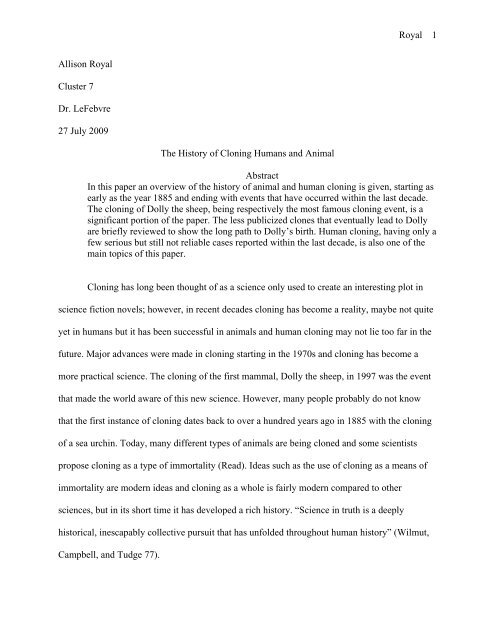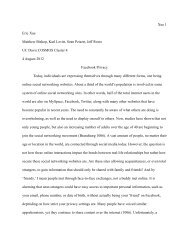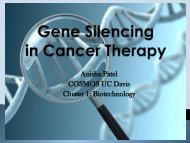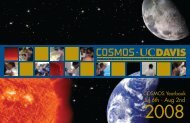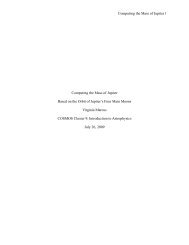The History of Cloning Humans and Animals - COSMOS
The History of Cloning Humans and Animals - COSMOS
The History of Cloning Humans and Animals - COSMOS
Create successful ePaper yourself
Turn your PDF publications into a flip-book with our unique Google optimized e-Paper software.
Royal 1<br />
Allison Royal<br />
Cluster 7<br />
Dr. LeFebvre<br />
27 July 2009<br />
<strong>The</strong> <strong>History</strong> <strong>of</strong> <strong>Cloning</strong> <strong>Humans</strong> <strong>and</strong> Animal<br />
Abstract<br />
In this paper an overview <strong>of</strong> the history <strong>of</strong> animal <strong>and</strong> human cloning is given, starting as<br />
early as the year 1885 <strong>and</strong> ending with events that have occurred within the last decade.<br />
<strong>The</strong> cloning <strong>of</strong> Dolly the sheep, being respectively the most famous cloning event, is a<br />
significant portion <strong>of</strong> the paper. <strong>The</strong> less publicized clones that eventually lead to Dolly<br />
are briefly reviewed to show the long path to Dolly’s birth. Human cloning, having only a<br />
few serious but still not reliable cases reported within the last decade, is also one <strong>of</strong> the<br />
main topics <strong>of</strong> this paper.<br />
<strong>Cloning</strong> has long been thought <strong>of</strong> as a science only used to create an interesting plot in<br />
science fiction novels; however, in recent decades cloning has become a reality, maybe not quite<br />
yet in humans but it has been successful in animals <strong>and</strong> human cloning may not lie too far in the<br />
future. Major advances were made in cloning starting in the 1970s <strong>and</strong> cloning has become a<br />
more practical science. <strong>The</strong> cloning <strong>of</strong> the first mammal, Dolly the sheep, in 1997 was the event<br />
that made the world aware <strong>of</strong> this new science. However, many people probably do not know<br />
that the first instance <strong>of</strong> cloning dates back to over a hundred years ago in 1885 with the cloning<br />
<strong>of</strong> a sea urchin. Today, many different types <strong>of</strong> animals are being cloned <strong>and</strong> some scientists<br />
propose cloning as a type <strong>of</strong> immortality (Read). Ideas such as the use <strong>of</strong> cloning as a means <strong>of</strong><br />
immortality are modern ideas <strong>and</strong> cloning as a whole is fairly modern compared to other<br />
sciences, but in its short time it has developed a rich history. “Science in truth is a deeply<br />
historical, inescapably collective pursuit that has unfolded throughout human history” (Wilmut,<br />
Campbell, <strong>and</strong> Tudge 77).
Royal 2<br />
<strong>Cloning</strong> before the 1990s was a science not well known among the public because major<br />
successes in this field involved non-mammalian animals; although these successes were far from<br />
the public interest <strong>of</strong> human cloning, they are still crucial to the development <strong>of</strong> mammalian<br />
cloning. <strong>The</strong> first successful cloning was that <strong>of</strong> a sea urchin by Hans Adolf Edward Dreisch in<br />
1885. <strong>The</strong> method <strong>of</strong> cloning used by Dreisch is embryo twinning, a cloning which occurs<br />
naturally when a mammal gives birth to twins. He separated the two-celled sea urchin embryo by<br />
shaking it until it split into two separate cells which then each grew into an independent<br />
organism. <strong>The</strong> scientist Hans Spemann, director <strong>of</strong> the Kaiser Wilhelm Institute <strong>of</strong> Biology in<br />
Berlin, also used embryo twinning to clone a salam<strong>and</strong>er in 1902. This time the organism was<br />
more complex (it had a backbone) <strong>and</strong> the cells <strong>of</strong> the embryo were much harder to split; the<br />
cells could not be separated by shaking them. Spemann was able to split the cells by creating a<br />
noose out <strong>of</strong> a str<strong>and</strong> <strong>of</strong> baby hair. <strong>The</strong> cloning was successful in this early stage <strong>of</strong> the embryo<br />
but when tried in a more advanced embryo the cloning was not successful (<strong>The</strong> University <strong>of</strong><br />
Utah).<br />
Although Dolly is the first mammal to be cloned using the process <strong>of</strong> nuclear transfer,<br />
there were any animals cloned before her using the same process. In 1952, the scientists Robert<br />
Briggs <strong>and</strong> Thomas King successfully cloned a common American frog. <strong>The</strong>y did this through<br />
nuclear transfer; they removed the nucleus from a tadpole embryo <strong>and</strong> placed it in a recipient<br />
frog egg cell that had had its nucleus removed, a process called enucleation (<strong>The</strong> University <strong>of</strong><br />
Utah). Out <strong>of</strong> 197 reconstructed embryos, 104 began development, 35 became embryos, <strong>and</strong> 27<br />
grew into tadpoles (Wilmut, Campbell, <strong>and</strong> Tudge 92). In 1958, scientist John Gurdon cloned the<br />
African clawed frog using nuclei from tadpole intestinal cells, meaning using cells that were<br />
differentiated <strong>and</strong> past the embryo stage <strong>of</strong> life (94). Derek Bromhall then applied the process <strong>of</strong>
Royal 3<br />
nuclear transfer to the rabbit, a mammalian organism whose cells are smaller <strong>and</strong> more complex<br />
than those <strong>of</strong> a salam<strong>and</strong>er or frog, in 1975. He was able to develop an advanced embryo after a<br />
few days but not yet an entire organism (<strong>The</strong> University <strong>of</strong> Utah). In the scientific journal Nature<br />
on March 1985 Steen Willadsen announced his successful cloning <strong>of</strong> sheep by nuclear transfer;<br />
this only differs from the Dolly cloning in the age <strong>of</strong> the nucleus used (Wilmut, Campbell, <strong>and</strong><br />
Tudge 151). Nuclear transfer was then used in a larger mammal, the cow, by scientists Neal<br />
First, R<strong>and</strong>al Prather, <strong>and</strong> Willard Eyestone (<strong>The</strong> University <strong>of</strong> Utah). <strong>The</strong>se calves, named<br />
Fusion <strong>and</strong> Copy, were cloned still using only embryonic nuclei. In 1996, shortly before the birth<br />
<strong>of</strong> Dolly, the same scientists that cloned Dolly, Wilmut <strong>and</strong> Campbell, cloned sheep from<br />
cultured mammalian cells instead <strong>of</strong> using donor cells from a developing embryo (<strong>The</strong><br />
University <strong>of</strong> Utah).<br />
<strong>The</strong> most famous cloning event in history may be the cloning <strong>of</strong> the first mammal, Dolly<br />
the sheep; this cloning was much more complicated than that done by Hans Spemann <strong>and</strong> it<br />
helped launch the modern cloning age. Dolly was born in 1996 after having been successfully<br />
cloned at the Roslin Institute in Scotl<strong>and</strong> by the scientists Keith Campbell <strong>and</strong> Ian Wilmut (<strong>The</strong><br />
University <strong>of</strong> Utah). Her existence was not announced to the world until March 1997 in the<br />
science journal Nature (Wilmut, Capmbell, <strong>and</strong> Tudge 1). Ian Wilmut stresses that Dolly was<br />
more important than other clones at that time because “she was the first animal <strong>of</strong> any kind ever<br />
to be created from cultured, differentiated cells taken from an adult” (232). Many, somewhat<br />
skeptical <strong>of</strong> the success <strong>of</strong> the cloning, made dire predictions about Dolly; some thought she<br />
would be sterile <strong>and</strong> one American newspaper announced that Dolly was a carnivore that ate her<br />
flock-mates (1). In reality, Dolly turned out to be an ordinary sheep. <strong>The</strong> only problem that could<br />
take away from this success was in 1999 when structures at the end <strong>of</strong> her chromosomes known
Royal 4<br />
as telomeres, which become shorter with age, were more typical <strong>of</strong> a much older animal (2).<br />
Dolly herself showed no signs <strong>of</strong> premature aging <strong>and</strong> in 1998 gave birth to her first lamb<br />
Bonnie, putting the sterility rumors to rest (2).<br />
In a science as controversial as cloning there is sure to be much legal action taken to<br />
create bounds so that this science does not develop into something that people fear. In 1995, with<br />
cloning technologies improving <strong>and</strong> the possibility <strong>of</strong> human cloning growing, President Bill<br />
Clinton formed the National Bioethics Advisory Council (NBAC). <strong>The</strong> NBAC consisted <strong>of</strong><br />
scientific experts <strong>and</strong> non-scientists that evaluated the ethical, legal, <strong>and</strong> religious issues<br />
concerning human research subjects (<strong>The</strong> University <strong>of</strong> Utah). Shortly after the Roslin Institute<br />
announced that they had cloned an animal, in February 1997, President Bill Clinton made an<br />
executive order that banned any federal funding <strong>of</strong> cloning research; but this did not prohibit<br />
privately funded research (Center for Genetics <strong>and</strong> Society). A year later, Democratic Senators<br />
Feinstein (CA) <strong>and</strong> Kennedy (MA) introduced a bill that would ban human reproductive cloning.<br />
Rebublican Senators Bond (MO), Frist (TN), <strong>and</strong> Lott (MI) competed with their own bill which<br />
banned both human reproductive cloning <strong>and</strong> the creation <strong>of</strong> clonal embryos (Center for Genetics<br />
<strong>and</strong> Society). Both bills failed to pass.<br />
Although human cloning is the subject <strong>of</strong> many science fiction novels <strong>and</strong> movies <strong>and</strong> is<br />
claimed to have been done, there is no credible record <strong>of</strong> it ever having been successfully<br />
executed. One <strong>of</strong> the most widely known reports <strong>of</strong> human cloning is that <strong>of</strong> Clonaid <strong>and</strong> its<br />
supposed clone Eve born in 2002 (Onstad). Besides Eve, Clonaid is claimed to have cloned 12<br />
other people (National Genome Research Institute). <strong>The</strong>se cases are not credible though since<br />
Clonaid would not agree to a DNA test between mother <strong>and</strong> child. Clonaid was established by a<br />
religious group called the Raelians in February 1997 (Clonaid). <strong>The</strong>y believe that aliens l<strong>and</strong>ed
Royal 5<br />
on Earth 25,000 years ago <strong>and</strong> started the human race through cloning (Onstad). <strong>The</strong> founder <strong>of</strong><br />
the religious group, Claude Vorilhon or “Rael”, claims that the Raelian movement <strong>and</strong> Clonaid<br />
are “very different”; he cannot support any claims that Clonaid has made (Onstad). Clonaid call<br />
themselves “pioneers in human cloning” <strong>and</strong> they claim their success rate in cloning is the same<br />
as other reproductive assisted techniques (Clonaid).<br />
Clonaid may feel that cloning will become very important in the future, <strong>and</strong> it may be, or<br />
the negative dogma surrounding cloning may end it forever; maybe Dolly was the climax. We<br />
live in a world now where we are starting to return to natural things since our extravagant,<br />
unnatural living is costing us our lives <strong>and</strong> the lives <strong>of</strong> our posterity; this new “green” society<br />
may not accept artificial cloning. It is unlikely that cloning will disappear forever though; many<br />
scientists have put too much time <strong>and</strong> commitment into it for that to happen. It definitely seems<br />
as though Clonaid is not ready to give up any time soon. <strong>The</strong>re are sure to be many more years <strong>of</strong><br />
cloning history to come. We can almost be certain that this science that is a part <strong>of</strong> our past <strong>and</strong><br />
present will stick around for our future.
Royal 6<br />
Works Cited<br />
McKinnell, Robert Gilmore. <strong>Cloning</strong>: A Biologist Reports. Minneapolis: University <strong>of</strong><br />
Minnesota Press, 1979. Print.<br />
Wilmut, Ian, Keith Campbell, <strong>and</strong> Colin Tudge. <strong>The</strong> Second Creation: <strong>The</strong> age <strong>of</strong> biological<br />
control by the scientists who cloned Dolly. London: Headline Book Publishing, 2000.<br />
Print.<br />
“Human <strong>Cloning</strong>”. American Medical Association. Web. 25 July 2009. <br />
“<strong>The</strong> Clone Zone.” Learn.Genetics. 12 Dec. 2008. <strong>The</strong> University <strong>of</strong> Utah. Web. 24 July 2009.<br />
<br />
Read, Catherine Y., Robert C. Green, <strong>and</strong> Michael A. Symer. “Aging, Biotechnology,<br />
Future.” JAMA. 1 July 2009. American Medical Association. Web. 21 July 2009. <<br />
http://jama.ama-assn.org/cgi/<br />
search&fulltext=cloning&sortspecbrief=date&sortspec=date><br />
Onstad, Eric. “World’s Second Cloned Baby is Born, Raelians Say.” Religion News<br />
Web. 4 Jan. 2003. <br />
<strong>and</strong> the<br />
Blog.<br />
“Why the legal <strong>and</strong> ethical issues surrounding cloning will be limited.” CNN.com/Lawcenter.<br />
Web. 26 July 2009.<br />
<br />
“<strong>Cloning</strong>.” National Genome Research Institute. 12 March 2009. Web. 26 July 2009.<br />
<br />
Clonaid: Pioneers in Human <strong>Cloning</strong>. 2006. Web. 25 July 2009.<br />
<br />
“Failure to Pass Federal <strong>Cloning</strong> Legislation, 1997-2003.” Center for Genetics <strong>and</strong><br />
Society. Web. 25 July 2009.


